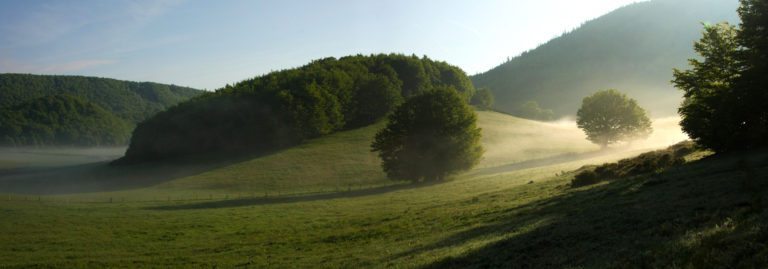Classification : Geosite of World UNESCO Geopark
Managing organization : ONF-CEN
Presentation :
The Vestide du Pal is a large filled maar crater, about 1700m in diameter and 150 deep, open to the southwest. As a result of the phreatomagmatic activity of the volcano, a series of small basaltic cones due to strombolian activity formed inside the crater.
The Vestide du Pal is characterized by two different dynamic volcanic phases. The volcanic activity first manifested itself in phreatomagmatic dynamism, the explosions of which produced a vast crater, approximately 1,700m in diameter. This dynamism is also recognizable by the presence of explosive products : base fragments, cauliflower bombs typical of phreatomagmatic eruptions (fine projections of the volcano have been found up in the Rhône Valley at the archaeological site of Soyons (Baume Moula), attesting to the power of the explosions whose height of the plume fluctuated between 1 and 15 km). On the site, the succession of explosions is clearly visible, especially under the Pal « suc » (located in the crater) where the products emitted during the explosion accumulated forming a bedding.
These elements are clear and with little solder grains ; it can be found in some places, up to almost 200m thick. When water was deficient in the phreatomagmatic mechanism, the volcano experienced a Strombolian dynamism : five “spatter cones” (basalt cones) of different sizes were placed in the crater of Maar. They therefore did not cover the phreatomagmatic “structure” of the Pal Vestide (unlike other volcanoes of this type such as the Chambon). These small cones, most of them located in the center of the crater, are not all visible but are easy to access. One of them has been eroded and is cut in half by the source of the Fontaulière river. These strombolian cones are essentially made up of red and black slag.
Scientific or educational interests :
It could be the largest maar crater in Europe. The Vestide du Pal volcanic system has been studied since the 18th century. More recently, two dates at around -49,000 years (Thermoluminescence) have been acquired on tephras. The presence of strombolian cones within the crater of Maar allows to represent the successive phases and evolution of this type of volcanism (phreatomagmatic then strombolian). The important products of maar (volcanic tuff and cauliflower bombs), the basalt rich in peridotite enclaves, red and black slag, tapered bombs, pseudo-flows allow a study on the formation of a maar as well as on volcanic projections, possibility of comparing phreatomagmatic and strombolian projections. Two dates which (K/AR) stall at around -26,000 years the age of the last eruptive episode corresponding to the upper flows.
Nearby, many other volcanic sites can be studied (Volcan du Chambon and its lahars, Suc de Bauzon and its flow in the Loire and especially Lake Ferrand whose origin is not determined (anthropic or volcanic).
Thematic key words : agroecology, agronomy, botany, woodcutting, cartography, dendrology, ecology, entomology, study of fauna, forest, geography, geomorphology, hydrogeology, hydrology, paleoclimatology, pastoralism, landscapes, pedology, topology 3D digitization, sciences of the territory, volcanology
Keywords typology of sites : volcanic site, panorama reading landscapes, agricultural or pastoral zone, peat bogs, mediation space.
Access modalities :
Free access all year round
Possible support : By geologists from the Geopark Scientific Committee
